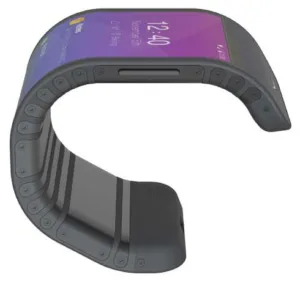At the recent Lenovo Tech World 2016 held in San Francisco, Lenovo showed two next generation prototypes based on flexible display technology. The first prototype was called CPlus. It is a conceptual smartphone / smartwatch that can also be worn as a band on a user’s wrist. The second prototype was called Folio and was a tablet that could be folded in half.
 Part of the incentive for the development of these prototypes was that Lenovo’s focus groups showed that people want to interact with the phone or tablet when it is folded. One implication of this preference is the need for a display that can bend outwards, not just inwards.
Part of the incentive for the development of these prototypes was that Lenovo’s focus groups showed that people want to interact with the phone or tablet when it is folded. One implication of this preference is the need for a display that can bend outwards, not just inwards.
In contemplating the development of such foldable devices, the company understood that “It is partly about screen technology. But it is also about the battery, the motherboard, how to make sure it holds its shape when you fold it back.”
While at this time there is little publically available information on the details of the hardware, Lenovo indicated that the mechanical design had been developed in conjunction with a major manufacturing partner and that the display technology was also provided by a partner.
In accordance with a statement by the company, an inspection of the CPlus showed that “CPlus has multiple hinges which allow it to curl up on itself through almost 360 degrees, creating a bracelet you can wear on your wrist.”
One of the more interesting aspects of both prototype devices was that, as they physically switched from flat to folded phone mode, their user interfaces also changed. This is described as being particularly important in that different form factors really need to have different user interfaces, user interfaces that best fit their function. Lenovo’s CPlus and Folio were reported to accomplish such changes in user interface in real time.
In the case of the CPlus, as it was folded, the screen’s app layout transitions into three sections. The top showed time, weather and notifications. The middle section presented media player controls. The bottom portion presented an app launcher.
In a bit of “theater,” when the CPlus was bent around a user’s wrist, the display seemed to “crack.” This was actually just a software distortion of the image presented on the display.
The CPlus included a 4.26″ flexible display and ran the Android operating system. It is reported that the device will eventually come in two sizes, large and small, and in a choice of 12 different colors.
In the case of the Folio, when in its’ flat configuration, it was reported to look just like any other Android tablet. The exception to this was the apparently odd layout of a large camera positioned below a large phone earpiece on the long edge of the device.
The reason for this arrangement becomes apparent when the Folio was folded in half along a hinge hidden between the camera and earpiece. The display bent around the outside of the chassis. During the folding process, one half of the display blacked out. The device was now configured to be held up to the user’s ear and used as a really large phone.
The prototype Folio demonstrated limited functionality. This was in contrast to the CPlus which was reported to appear as a more “polished” prototype. The difference may be a reflection of the fact that significantly more development time and effort was available for the production of the CPlus prototype.
There are many videos on-line demonstrating the Lenovo prototype devices. The first video found at the end of this article discusses the CPlus. The second video discusses the Folio.
Lenovo CTO Peter Hortensius, stated that these devices could be expected in the market within five years. – Arthur Berman

